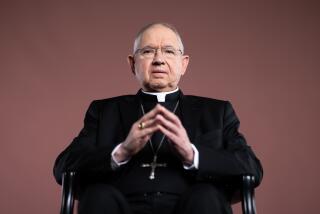PREVIEW / PAPAL VISIT TO MEXICO : John Paul II: No Accidental Latin Tourist
- Share via
VATICAN CITY — On one of Pope John Paul II’s frequent visits to the parishes of Rome, an Italian schoolboy asked him why he traveled so much.
“Because not all the world is Rome,” the Pope replied.
John Paul should know. He’s been there, from Arctic fjord to South Sea island, African slums to the sites of concentration camps in Europe. Next week: a Mexican jail.
What makes the Pope run? He thinks it is, for one thing, a responsibility of the office. For another, he enjoys it.
On Sunday, John Paul will begin another exhausting foreign pilgrimage, the 47th of his reign. It will include 10 Mexican cities in eight days, with a stop for prayers and jet fuel at the Caribbean island of Curacao on the way home.
The Mexico trip, the third abroad for John Paul this year, in effect begins a second round of travel by a Roman pontiff who has seen more of the world than all his predecessors combined.
Indeed, it was with his first trip--to Mexico in January, 1979, a few months after his election--that John Paul served notice of a new, on-the-move papacy. By now, the centuries-old image of an aloof, remote, Rome-bound Pope are as dated as chain mail and daguerreotypes.
“This is not a Pope who likes walls around him,” said Joaquin Navarro, who has accompanied John Paul on most of his trips, first as correspondent for a Spanish newspaper and later as papal spokesman. “He will not sit in a nunciature receiving visitors. He loves personal contact, and he wants five or six meetings a day--not only churches, but also slums, factories, jails.”
In its way, that first Mexican trip wrote the rules for all that have followed. Important details have changed and organizational details have been smoothed, but the practical and theological underpinnings are constants.
This will be John Paul’s 10th visit to Latin America, and it is hardly coincidental that Latin America is home to nearly 40% of the world’s 900 million Roman Catholics.
John Paul has made it clear that he sees travel as a major means of fulfilling his teaching and preaching role as the successor to St. Peter, the first Pope. For Catholics, he is a visible sign of their faith, just as his presence is a powerful means of cementing local churches to Rome.
“Quite simply,” Navarro said, “the Holy Father believes that people all over the world have the right to see their Pope, and he has the right to be with his people, wherever they are.”
No aide would ever say it, but they all understand that the Pope enjoys getting away from the strictures of managerial and ceremonial life at the Vatican. Here, he is in effect a prisoner in his apostolic palace. If he wants a breath of fresh air, he walks on the palace roof.
Often John Paul looks wan and tired when trips begin. But at their arduous end, while those in his retinue stagger from the last accursed bus to the blessed last plane, he seems perky, refreshed.
John Paul is as hardy as ever, his aides insist, but he is visibly older now, more stooped, and his travels are much more carefully packaged.
For a then-inexperienced Vatican, the Pope’s first visit to Mexico, survivors say, was a masterpiece of disorganization. He had gone principally to address a meeting of Latin American bishops wrestling with the implications of the activist theology of liberation.
But while he was there, at the urging of Mexican bishops and with the consent of his staff, John Paul tried to do too much. He wound up massively overprogrammed.
This time, Mexican bishops proposed 19 stops in eight days. Vatican planners, by now veterans of a to-the-minute schedule, cut it to 10.
The Pope will get his five or six events a day in Mexico, including a meeting with inmates at a penitentiary in Durango. But he will also get at least eight hours’ rest every night.
More to Read
Sign up for Essential California
The most important California stories and recommendations in your inbox every morning.
You may occasionally receive promotional content from the Los Angeles Times.













